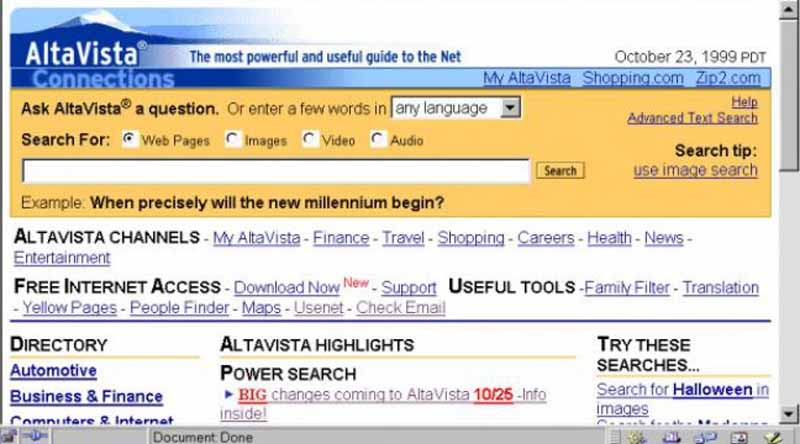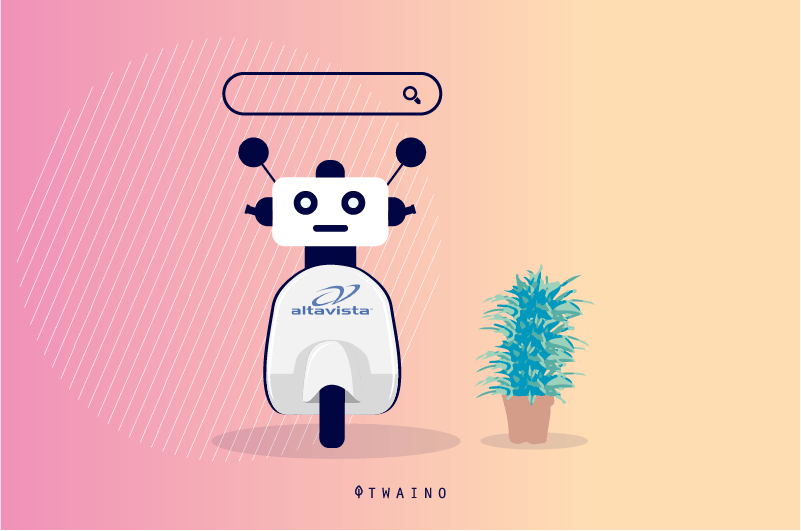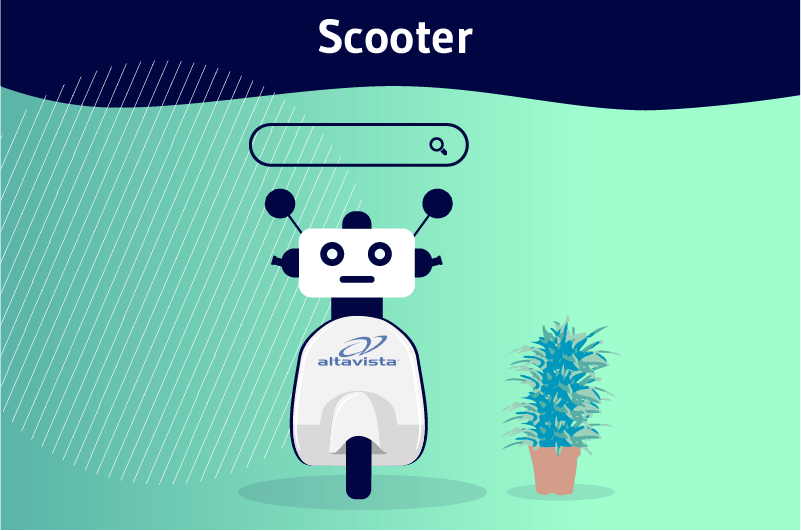Scooter is the name of Alta Vista’s crawler, the world’s first search engine that allowed people to search the Internet in natural language. This means that Scooter was the best crawler of its time.
When Alta vista first appeared on the World Wide Web, it surpassed all other search engines in popularity because of scooter, its crawler.
Unlike all other crawlers of that time, scooter could crawl the web very quickly to find new pages with different relevant content each time for the same query.
Its search capability was incomparable, it served as a pioneer for the most popular search engines of today.
So,
- What is Scooter?
- What are the syntaxes that best trigger Scooter to crawl pages?
- How did it disappear?
These are the three main questions we will answer in this article, we invite you to follow them.
What do we mean by Scooter?
First of all, to understand the meaning of Scooter, we have to start with the history of Alta Vista search engine.
First, AltaVista was the first search engine to allow natural language queries on the World Wide Web while offering a degree of depth that most search engines did not have at the time.

Source: definitions-seo
The search engine was launched in 1995 by a digital team located in California
The powerful search engine was able to run on its Scooter craw ler developed by the same team.
On the first day of its release, the search engine could already handle more than 300,000 queries.
Three weeks later, the number of 300,000 daily queries increased to two million. This demonstrates the ability of the Scooter crawler to deliver content that searchers are truly interested in.
Thanks to its magical success, Scooter can now crawl over 100 million pages by processing over 20 million queries per day in 1998.

Due to Scooter‘s extreme capacity, several other search features have been added to further expand its popularity. That said, scooter can now search for:
- Videos;
- Images
- Sounds;
- Or other queries with family filters.
Technically, Scooter ‘s formidable capability lies in hosting the site on 3 different alpha 500/333s digital stations.
However, each of these stations has a capacity of 256 Megabytes of Ram in addition to a 6 Gigabyte hard drive for storage
Seven different alpha 8400 5/300 servers have been installed to run the search engine systems. This group of servers consists of 10 processors, 6 Giga of Ram and a hard disk of storage of 210 Giga.
Each of these servers could describe the entire web index with a global size of 60 Giga. This is also a reason why Scooter can process and crawl pages for a request in half a second.
To get to the main reason for Scooter’s performance, it relies on an AlphaServer 4100 5/300 system with a capacity of 1.5 GB of Ram and 30 GB of storage memory
How to use syntax for efficient page crawling by Scooter?
Searches in the Alta Vista engine are categorized into two modes:
The simplest searches
Here queries are considered a series of simple or compound words and the most important operator is “Or”.
The use of the + symbol imposes a specific term on Scooter;
The – symbol tells the crawler to avoid a term;
The use of quotation marks allows Scooter to better consider the term when exporting;
The use of upper and lower case letters also has a lot of influence on how Scooter can crawl the pages.
You can see this in detail in this table:
| The use of upper and lower case | The use of upper or lower case does not have a significant influence on the search result, even though it is part of the syntax that boosts scooter’s crawl. For example: A query ”PIZZA” may display a result ”Pizza” or ”pizza”. |
| Terms composed of letters with accents | When the query contains a letter without accent, all occurrences can be explored by the bot. For example, ”energy” can find ”energy” or ”energy”; When the query contains a letter with an accent, Scooter explores only the exact occurrences. For example, a query ”égalité” finds exactly ”égalité” and not ”egalité” or ”egalite”. |
| The order of words in a query | Here, the robot does not give much importance to the order of words. For example, when you type ” Cotonou Paris” the robot can explore ”Paris Cotonou” |
| The use of ”Or | When you use the search operator ”Or” in a sentence like ”engine or search”, Scooter will explore the pages with the keyword ”engine” and those with the term ”search”. |
| The use of ”And | The operator ”And” is also translated by the symbols +. If you search for ”SEO+SEM”, only the pages that contain both ”SEO” and ”SEM” will be explored by Scooter. |
| The use of ”Except | In the case of the query ”SEO-SEM”, the robot will explore the pages with ”SEO” except those containing the keyword ”SEM”. |
| The use of an expression | When you search for ”La casa de papel”, the bot Scooter will explore the pages with the four words aligned one after the other. |
| The use of truncation | Here, we are talking about the use of the asterisk. For example, word* allows Scooter to guess the ending of the term by exploring words like motorcycle, motor, etc. |
| Linguistic search | Scooter can understand the search syntax in 25 different languages. |
| Search for a content title | The search operator here is the “title”. For example ”title: duplicate content” allows the bot to search for pages with that exact title. |
| Search the domain | When you search for example +pizza+domain:edu, Scooter will search for pages with the keyword pizza and whose domain ends with edu. |
| Search on the server name | Here, the query will mainly concern the name of the hosts. For example + engine+host:seo allows the bot to search for pages containing the word engine, whose address contains seo. (www.seo.com). |
| Search directly for a URL | When you search for e.g. +resto +url:pizza, Scooter will search for pages with the keyword resto whose address includes the word pizza. (www.unico.com/duo/pizza.html). |
| Searching for similar sites | the search operator to use cic is ”like:”. For example when you type like:http://www.pizza.com/ the results will display websites similar to pizza. |
| Query based on the name of a Java applet | The syntax here will be ”applet:” A query like applet:javacategorie8 can display pages with the category name javacategorie8. |
| Query from the name of an image | Google most search engines, Alta vista can display images for a given query. For example the syntax image:seo will display all pages containing an image with the name SEO. |
| Search directly for an Url address | Searching directly for a link involves using the ”link:” syntax. For example, if you search for link:infography.com, the scooter will search for content with a link leading to a page whose url contains ”infography.com. |
| Search from a keyword in the url | The syntax used here is ”anchor:” The request ”anchor:seo” allows the bot to find all pages whose link contains the keyword seo. Thus, the word in the links found will be underlined or colored. |
| Search the text immediately visible on the page | The syntax involved here is ”text:” For example text:seo allows the bot to explore the pages whose word seo can be read in the text on the page. |
The most advanced searches
The queries are more complex when they necessarily need to include the search operators ”AND, OR, NOT or NEAR” in capital letters to compose a query of several terms.
Some of the search operators we have seen in simple queries will also be used in complex queries.
But the specificity here is that the robot can search a page based on HTML tags.
The table below gives the list of functions:
| EXCEPT | AND NOT (or !) An example of a query with this syntax might be, SEO and not SEM. This is to tell the Scooter bot that it should only crawl pages with the word SEO. |
| NEAR | NEAR (or ~) This syntax lets the bot know that you need results with the first term, or you need pages with the second term. Here, it’s one or the other. For example, with SEO NEAR SEM, you will either get results for SEO or for SEM. |
| Parentheses | The use of parentheses tells the bot that this is a paired query. For example, (SEO AND SEM) AND NOT (SEO AND PPC) allows the bot to crawl only pages with SEO AND SEM. |
| Queries based on content dates | When you want credible information, you also need to make sure it’s current. So, to order topical queries to scoot in time, you would use the syntax By date range: and To The bot will immediately know that it should only crawl pages within your specified time range. Scooter uses the dates of the last modifications of a page to present the results. |
The AltaVista search engine can handle queries in different languages, mainly French, English, Spanish, etc.
To be more satisfied with your queries, it was better to use the syntaxes to perform advanced searches
The search engine provides results from various sources:
- It can from its own database: The bot scooter is in charge of exploring the pages which are then sorted by relevance;
- The results can also come from AskJeeves: This is a tool that the search engine uses at some point.
How did Scooter disappear from the market?
In 1996, search results on Yahoo are mainly provided by the AltaVista search engine. This would mean that at some point, Scooter had become Yahoo’s primary crawler.
Two years later, the engine was sold to the Compaq company, which turned it into a portal, one year after its purchase, that is, in 1998.
Thus, it was added more important features:
- The purchase of goods and services;
- The electronic mails.
That same year, the company compaq had to pay a sum of 3.3 million dollars to the initiators of the project for the domain name.
This move away from AltaVista’s simplified search experience made AltaVista more similar to its competitors. Users gradually began to switch to a newcomer, Google, for the simple search they were missing.
In 1999, AltaVista’s majority share was acquired by CMGI, owner of the Lycos search engine. It was valued at about $2.3 billion and an IPO was on the cards
But in 2001, its IPO was canceled and the staff was laid off because CMGI would have had trouble making AltaVista profitable.
At that time, Google surpassed AltaVista’s popularity with users, processing more search queries than its rival for the first time
AltaVista began to backtrack on its portal layout experience and return to a simple search form, but the damage was already done.
The struggling AltaVista brand was bought out in February 2003 for just $140 million by Overture
Then Yahoo acquired Overture four months later, which marked the beginning of the end for the AltaVista name
All of the search technology that had been developed under the AltaVista brand was absorbed into Yahoo search in 2011, just as its search results had been co-opted by Yahoo 15 years earlier.
Yahoo quietly shut down AltaVista in 2013.
Conclusion
So we can come to the conclusion that Scooter is the Alta Vista crawler, and indeed the most successful one of its time.
Even though it no longer exists on the market today, it served as the basis for the techniques that all the other most advanced search engines use today.
In this article, we have discussed in detail some of Scooter’s favorite syntaxes when searching back in time.



